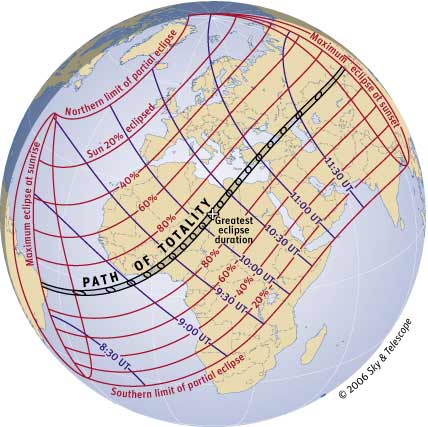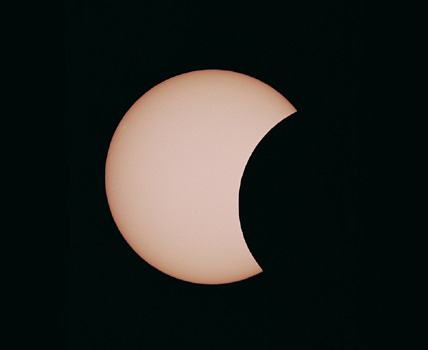-----------------------------------------
Update: Scroll down for live webcasts!
-----------------------------------------

This map shows the path of the umbral shadow (total eclipse). A partial eclipse can be seen over a much broader region, including most of Africa, parts of Asia, and all of Europe and the Middle East. Red lines indicate how much of the Sun's diameter is covered at maximum partial eclipse. Purple lines tell when this happens, in Universal Time (UT or GMT).
Sky & Telescope diagram / Source: Fred Espenak
On Wednesday, March 29, 2006, a total eclipse of the Sun will sweep across parts of West and North Africa, Turkey, and Central Asia. The eclipse will be partial across a much wider region, including most of Africa, all of Europe, and much of western and southern Asia.
The maps above and below tell the story. If you're in one of those parts of the world, you can use them to plan your activities on the big day.
A solar eclipse happens when the Moon crosses the face of the Sun as seen from your viewpoint on Earth. The globe map above shows the entire region of Earth that will be touched by any part of this eclipse, including the complete path of totality: where the Sun will become completely covered by the Moon. As the map shows, the total eclipse starts at sunrise at the tip of Brazil, crosses the Atlantic in the morning, the Sahara Desert at midday, Turkey in the afternoon, and ends at sunset in Central Asia. Red lines on the globe map indicate how much of the Sun's diameter is covered at maximum partial eclipse. Purple lines tell when this happens, in Universal Time (UT; also called Greenwich Mean Time or GMT).
The close-up map of Europe and the Middle East below gives more detail. Here, blue and red lines tell the start and end times of partial eclipse, respectively, again in UT/GMT. The partial eclipse is at its maximum halfway between these times at your site. The black lines on the map tell the percentage of the Sun's diameter that will be covered at maximum eclipse.
What To Look For
Although a partial solar eclipse can't hold a candle to a total one, it's a memorable celestial event in its own right. Can you see a change in the illumination of the landscape around you? A partial eclipse has to be surprisingly deep to alter the light visibly, because our eyes are very good at adjusting to ambient light levels. But when this does happen, the world seems to take on an odd, silvery feel like no other. Look for crescent-shaped dapplings on the ground where sunlight shines through leaves. In a safely solar-filtered telescope (see below), look for mountain silhouettes on the Moon's dark edge. Look too for a difference between the Moon's complete darkness and the not-so-complete darkness of any sunspots that the edge of the Moon approaches.
Warning: Never look at the bright surface of the Sun without proper eye protection! Examples are special "eclipse glasses" properly designed for the purpose, a #14 rectangular arc-welder's filter, or special astronomers' solar filters (see our list of solar filter suppliers). Staring at the bright Sun can burn your retina, leaving a permanent blind spot in the center of your vision. The only reason a partial eclipse poses a special danger is because it can prompt people to look directly at the Sun, something they wouldn't normally do. See our complete descriptions of the various ways to watch safely, including the "projection method" using a pinhole, binoculars, or a telescope.
Looking while the Sun is totally eclipsed, on the other hand, is safe. At that time, of course, none of the Sun's bright surface is in view.
People who've never tried photographing a solar eclipse before can get fine results by following Sky & Telescope's tips for photographers.
More on this particular eclipse appears in the January and March 2006 issues of Sky & Telescope, the essential magazine of astronomy.
For detailed local predictions at any given location, please see NASA's Web site for this eclipse.
See also Larry Koehn's cool eclipse animations.
Live webcasts:
NASA/Exploratorium Eclipse Webcast: 5:00 to 6:15 a.m. Eastern Standard Time March 29th, live from Side, Turkey. During the webcast NASA will contact scientists in Turkey and Libya observing the eclipse. See schedule.
Watch the eclipse on NASA TV.
Webcast from University of Cape Coast, Ghana.
Live Eclipse 2006 (from Libya, Egypt, and Turkey; in English or Japanese).
Klipsi (in Egypt).
Sun Earth Moon system (University of North Dakota; from Turkey).
University of Athens, Greece (partial eclipse).
Sky & Telescope grants permission to reprint the graphics with this article for one-time, nonexclusive use, as long as appropriate credits (as noted in the captions) are included. Web publication must include a link to SkyandTelescope.com. For high-resolution, publication-quality versions, see our press release

Although nothing of the March 29, 2006, solar eclipse can be seen from North America, all Europeans can observe the partial phases — weather permitting. Use this map to find when the eclipse begins and ends at your location; times are Universal Time (UT or GMT). The curves labeled with percentages indicate what fraction of the Sun's diameter will be blocked by the Moon at maximum eclipse.
Sky & Telescope diagram.

These views show the Sun's appearance at the times of greatest eclipse on March 29, 2006, for various cities, as seen by an observer who stands facing the Sun and looks through a safe solar filter.
Sky & Telescope illustration.

A partial solar eclipse. On May 10, 1994, an annular eclipse was seen along a narrow path across Mexico and the United States. However, virtually all North Americans with clear skies could see the Sun's disk at least partially covered by the Moon. This image was taken with an 8-inch Schmidt-Cassegrain telescope from Ogonquit, Maine.
Sky & Telescope: Richard Tresch Fienberg.
 0
0
Comments
You must be logged in to post a comment.